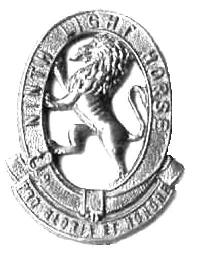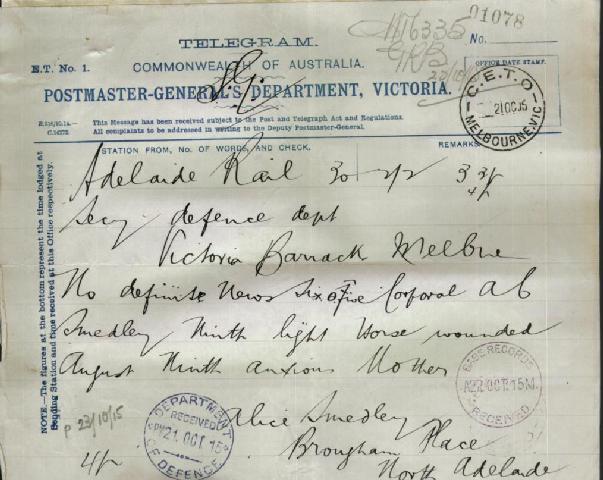Topic: GW - We forgot
Great War Issues
Lest We Forget - But We Did Anyway
Leonard Pitchers
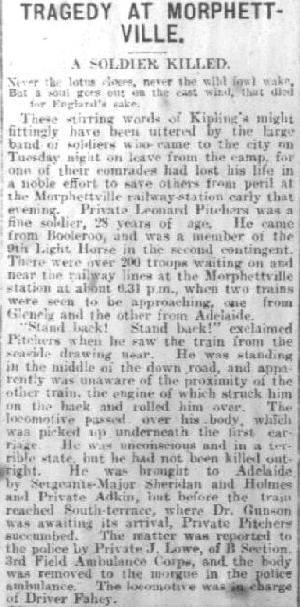
The Accident of Leonard Pitchers
[Adelaide Chronicle, 17 October 1914, p. 45.]
The story of Leonard Pitchers
Now we come to the events at Morphettville Station at 6.15 pm on 13 October 1914. The story of Pitchers is very straight forward. After a day of work at Morphettville Race course, 200 men, including Pitchers, headed off to the nearest rail station to catch the Glenelg train to Adelaide. [As a historical note - this track has long since been ripped up but the permanent way in the remaining rail reserve is very visible.] While at the platform, men were spilling over onto the rails. Pitchers saw the train coming from Glenelg and helped to shepherd the men out of the way. In doing so, he was so concentrating on his task that he failed to see the train coming from Adelaide to Glenelg which knocked him down. Pitchers was taken to Adelaide Hospital where he died from his injuries.
Newspaper Reports
1. Adelaide Chronicle
Here is the story as it appeared in the Adelaide Chronicle, 17 October 1914, p. 45:
Tragedy at Morphettville
A Soldier Killed
Never the lotus closes, never the wild fowl wake,
But a soul goes out on the east wind, that died for England's sake.
These stirring words of Kipling's might fittingly have been uttered by the large band of soldiers who came to the city on Tuesday night on leave from the camp, for one of their comrades had lost his life in a noble effort to save others from peril at the Morphettville railway-station early that evening. Private Leonard Pitchers was a fine soldier, 26 years of age. He came from Booleroo, and was a member of the 9th Light Horse in the second contingent. There were over 200 troops waiting on and near the railway lines at the Morphettville station at about 6.31 pm, when two trains were seen to be approaching, one from Glenelg and the other from Adelaide.
"Stand back!" Stand back!" exclaimed Pitchers when he saw the train from the seaside drawing near. He was standing in the middle of the down road, and apparently was unaware of the proximity of the other train, the engine of which struck him on the back and rolled him over. The locomotive passed over his body, which was picked up underneath the first carriage. He was unconscious and in a terrible state, but he had not been killed outright. He was brought to Adelaide by Sergeants Major Sheridan and Holmes and Private Adkin, but before the train reached South Terrace, where Dr. Gunson was awaiting its arrival, Private Pitchers succumbed. The matter was reported to the police by Private J Lowe, of "B" Section, 3rd Field Ambulance Corps, and the body was removed to the morgue in the police ambulance. The locomotive was in charge of Driver Fahey.
Men mentioned in the article in order of appearance:
Corporal William SHERIDAN, formerly of the Royal Highlanders, appointed Corporal, Instructional Staff, 16 September 1914, and later 5128 Sergeant William SHERIDAN, 32nd Battalion, 14th Reinforcement.
Sergeant William HOLMES, formerly of Royal Garrison Artillery, appointed Sergeant, Instructional Staff, 16 September 1914. Promoted to Staff Sergeant Major.
162 Private Horace Bismark ATKINS, 3rd Field Ambulance, B Section.
109 Private John Hubert LOW, 3rd Field Ambulance, B Section.

Dr John Bernard GUNSON, Angas St, Adelaide, son of Dr John Michael Gunson.
2. Laura Standard
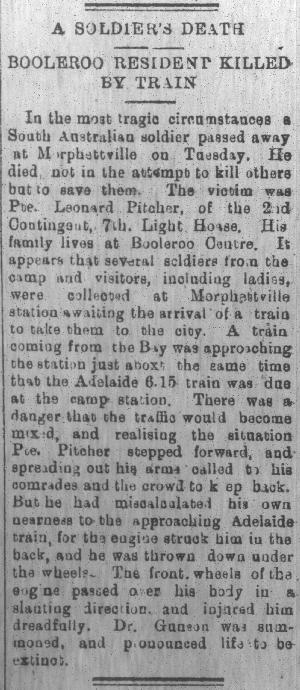
The Accident of Leonard Pitchers as seen at Laura
[Laura Standard, 16 October 1914, p. 3.]
Here is the article that appeared in the Laura Standard 16 October 1914 at p. 3:
A Soldier's Death
Booleroo Resident Killed by Train
In the most tragic circumstances a South Australian soldier passed away at Morphettville on Tuesday. He died no in the attempt to kill others but to save them. The victim was Pte Leonard Pitcher, of the 2nd Contingent, 7th Light Horse. His family lives at Booleroo Centre. It appears that several soldiers from the camp and visitors, including ladies, were collected at Morphettville station awaiting the arrival of a train to take them to the city. A train coming from the Bay was approaching the station just about the same time that the Adelaide 6.15 train was due at the camp station. There was a danger that the traffic would become mixed, and realising the situation, Pte Pitcher stepped forward, and spreading out his arms called to his comrades and the crowd to keep back. But he had miscalculated his own nearness to the approaching Adelaide train, for the engine struck him in the back, and he was thrown down under the wheels. The front wheels of the engine passed over his body in a slanting direction and injured him dreadfully. Dr Gunson was summoned and pronounced life to be extinct.
3. The Critic
The Critic of 21 October 1914 posted this story at p. 6:
THE MENACE OF MORPHETTVILLE.
The tragic death of a gallant young soldier at the Morphettville railway station the other day ought to point once more to the menace of railway stations that have no platforms.
Morphettville is a glaring instance. The soldier stood on the rails to warn the waiting crowd of the approach of one train, and the other from the opposite direction dashed into him and he was killed. There ought to be a bitter lesson here for the Railways Commissioner. It is the demonstrated danger of allowing two trains to be simultaneously in a station that has no platform. A greater death trap could hardly be imagined. The railway authorities may urge-and not without some force -that the unfortunate young fellow who lost his life was almost wholly to blame. He should not have been on the rails. Probably not; but it is the duty of the department to minimise the risks to which travellers are exposed. Its business is to provide safeguards.
The point "The Critic" wishes to make is that, even allowing for the tragic mistake on the part of the deceased soldier, it should hardly have been possible for him to have been placed in the awful position in which he found himself. That other train should not have been allowed to enter the Morphettville station until the one for Adelaide had left. Is it not clear in these and similar circumstances before, that the simultaneous appearance of two trains at the station should be absolutely avoided in the future? The public, at any rate, will think so.
The first problem encountered with Pitchers is the total lack of documentation about him on any of the national service databases. There is no Service File held by the National Archives of Australia and it is suspected his paperwork disappeared as quickly as he did himself, mainly through the lack of an ajutant within the 9th Light Horse Regiment at that time.
The Testimony of George Frederick Gardells WIECK

Captain George Frederick Gardells WIECK was a career military man who was appointed Adjutant of the 9th Light Horse Regiment on 13 November 1914. In his unpublished account of his time with the 9th Light Horse Regiment, he has this to say about the situation he encountered when he arrived at Warradale.
Here is his account:
The Officer question was even more difficult. The only officers available were those who were not considered good enough for the 3rd LH Regiment. Those who had experience were devoid of character and unable to teach and guide those who had none. Several of the junior officers had had no military training whatever - It will be realised that the task of selecting his officers was not the least difficult the C.O. had to contend with. In spite of all efforts of the C.O. no adjutant was available until an officer of the A & I Staff was appointed on 13th November 1914 and the Orderly Room work was in a state of chaos. For reasons not clear the Commanding Officers set his face against and recommendation for the position of Second in Command; he consistently stated that he could manage quite well without but it is strongly suspected that he could see no one in whom he could place the requisite confidence. As a matter of fact, at this stage a Second in Command would have been invaluable for supervision of training of officers and N.C.Os, and for co-ordinating the progress of "C" Squadron.
This vignette paints a devastating comment about the competence of administration in the 9th Light Horse Regiment at the time of Leonard Pitchers death and could explain the loss of his records.
For more information on George Frederick Gardells WIECK and his published work, See:
Public Records
So let's look at the things we do know.
Birth Certificate
Here is the extract from his Birth Certificate.
| Surname: | PITCHERS | |
| Given Names: | Leonard | |
| Date: | 6 December 1880 | |
| Sex: | Male | |
| Father: | Henry PITCHERS | |
| Mother: | Rose SOUTHWOOD |
From the above, it was possible to compile the family genealogy at the time of the birth of Leonard Pitchers.
Parents
Henry Pitchers (1837-1909) and Rosa Southwell (1837-1899) were married on 8 March 1858 in Hindmarsh Valley, Adelaide, South Australia, Australia.
Children
William Henry Pitchers (1858-1927);
John Southwell Pitchers (1860 - ?);
Frank Pitchers (1862-1939);
Gertrude Pitchers (1864-1913);
Sarah Preston Pitchers (1866 - ?);
Alfred Pitchers (1868-1903);
Rose Pitchers (1871- ?);
Elizabeth Pitchers (1873- ?);
Ernest Pitchers (1874-1949);
Florence (Doll) Pitchers (1876- ?);
Lucy Alice Pitchers (1878- ?); and,
Leonard Pitchers (1880-1914).
The Will
On the 8 October 1914 he wrote out his will witnessed by two law clerks in Adelaide. Probate was granted on 25 January, 1915. The beneficiaries and executors were his brother Ernest and his sister Lucy Alice WILSON nee PITCHERS. The estate was sworn not to exceed £2,500.
Coroner's Report
The first problem is the coroner's report. There was none. There is a file - The State Records reference is GRG1/44 - 13/10/1914 - No 364 - which apart from the detectives reports that summarise the reports in the newspapers, there is little else.
Death Certificate
His Death Certificate extract provides us with very little information:
| Surname: | PITCHERS | |
| Given Names: | Leonard | |
| Date: | 13 October 1914 | |
| Sex: | Male | |
| Age: | 34 years | |
| Status: | Single | |
| Relative: | ||
| Relative 2: | ||
| Residence: | Booleroo Whim | |
| Death Place: | Adelaide |
It does raise issues of information conflict. The newspaper report mentions Pitchers as being 28 while his birth and death certificates confirm that he was 34 years of age. This is relatively minor considering that the notion of age was quite a flexible concept in the AIF at the time. Men changed their ages to fit in with the desirable criteria for selection.
7th or 9th Light Horse Regiments
One conflict of information raised in the newspaper stories is the identification of Pitchers as being in both the 7th and 9th Light Horse Regiments. His death occurred in the week when a name change occurred. At the beginning of his service, Pitchers was enrolled in "B" Squadron, 7th Light Horse Regiment, a composite Regiment made up of a squadron from New South Wales, South Australia and Western Australia. The 7th Light Horse Regiment was formed at the beginning of October 1914, with Lieutenant Colonel Miell as the Commanding Officer. The overflow of New South Wales recruits meant that the 7th Light Horse Regiment was over subscribed in that state allowing the authorities to raise a new composite regiment based in South Australia which would provide two squadrons and Victoria, one squadron. Again Lieutenant Colonel Miell, a South Australian, was appointed as the Commanding Officer.
See:
7th Australian Light Horse Regiment, AIF, Outline
and
9th Australian Light Horse Regiment, AIF, Outline
Pitchers was in the 7th Light Horse Regiment, "B" Squadron during the first week of October but in the 9th Light Horse Regiment, "A" Squadron during the second week of October at the time of his death.
Public Acknowledgement
At the time, in 1914, Pitchers was acknowledged and recognised by his local communities. His death was memorialised on two Rolls of Honour.
Booleroo Centre

[From Tributes of Honour, SA & NT War Memorials.]
The entry on the Roll of Honour at the Booleroo Centre Institute reads:
PITCHERS L. Accidentally Killed Whilst In Camp
Hammond
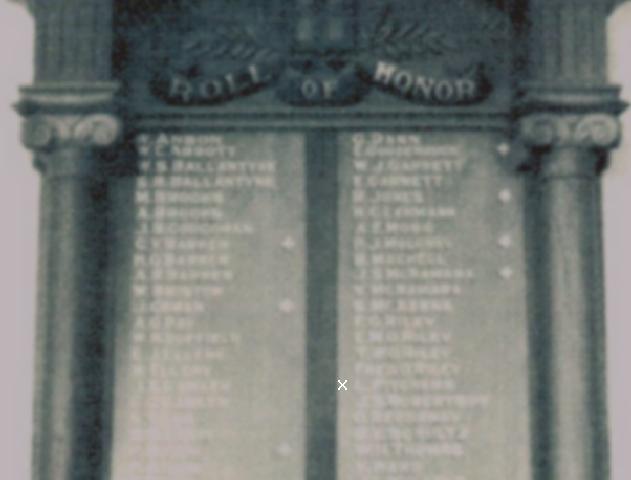
[From Tributes of Honour, SA & NT War Memorials.]
The entry on the Roll of Honour at Hammond reads:
L PITCHERS
In contrast, no entry for Pitchers appears on the South Australian War Memorial nor is there an entry on the Roll of Honour at the Australian War Memorial, nor has he been granted a Commonwealth War Graves Commission grave.
Location of Grave
In fact, currently, no one knows quite where Pitchers was buried. It was certainly not West Terrace Cemetery, the most logical place. West Terrace Cemetery was in easy transport distance between the Adelaide Hospital and Morphettville. There is no information about who paid for the funeral although judging from the news story, it is likely that this task was undertaken and paid for by the AIF. However, this is just supposition based upon later history since there were no funeral notices or anything of that nature to help assist in resolving this matter.
Conclusion
Leonard Pitchers, who was killed through being run over by a train, earned him the unenviable distinction of being the first 9th LHR man to be killed while on active service. Yet he is not remembered on the Roll of Honour at the Australian War Memorial nor on the Adelaide War Memorial.
"Lest we forget"
Ironically, he was forgotten and still remains officially forgotten. Perhaps in the future Pitchers may be publicly remembered.
Further Reading:
Tributes of Honour, SA & NT War Memorials, Booleroo Centre Institute
Tributes of Honour, SA & NT War Memorials, Hammond
Lest We Forget - But We Did Anyway
Battles where Australians fought, 1899-1920
Citation: Great War Issues, Lest We Forget - But We Did Anyway, Leonard Pitchers




